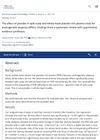TLDR Platelet Rich Plasma (PRP) treatment significantly improved Female Pattern Hair Loss in a study, but more trials are needed for confirmation.
This placebo-controlled case study evaluated the effectiveness of Platelet Rich Plasma (PRP) treatment on 14 female patients aged 20-45 years with Female Pattern Hair Loss (FPHL). Only 10 patients completed the study, with 7 receiving PRP and 3 receiving a saline placebo. The PRP group showed significant improvement, with 5 subjects showing 26-50% improvement and 2 showing 51-75% improvement, while the placebo group showed 0-25% improvement. The study concluded that PRP is a simple, cost-effective, and feasible treatment for FPHL with a good safety profile, but more extensive trials are needed to confirm these results.
 January 2022 in “Journal of Cosmetic Dermatology”
January 2022 in “Journal of Cosmetic Dermatology” Placebo effects vary in hair loss trials, with split-scalp trials showing higher hair density after 6 months compared to whole-head trials.
 12 citations
,
March 2019 in “Journal of Cosmetic Dermatology”
12 citations
,
March 2019 in “Journal of Cosmetic Dermatology” PRP injections improve hair thickness and density in hair loss, but more research needed.
 5 citations
,
March 2018 in “Clinics in Dermatology”
5 citations
,
March 2018 in “Clinics in Dermatology” PRP injections and scalp lifting together improve hair thickness and growth in hair loss patients.
 33 citations
,
January 2017 in “Journal of Cutaneous and Aesthetic Surgery”
33 citations
,
January 2017 in “Journal of Cutaneous and Aesthetic Surgery” Platelet-rich plasma injections can effectively treat male pattern hair loss, improving hair density and quality with high patient satisfaction.
 87 citations
,
September 2016 in “Dermatologic Surgery”
87 citations
,
September 2016 in “Dermatologic Surgery” PRP shows potential for treating female hair loss, but more research needed.
 115 citations
,
January 2014 in “Journal of Cutaneous and Aesthetic Surgery”
115 citations
,
January 2014 in “Journal of Cutaneous and Aesthetic Surgery” Platelet-rich plasma (PRP) is a cheap and easy treatment for hair loss, but not suitable for everyone. It also helps in healing ulcers, rejuvenating skin, and improving hair transplants.
 9 citations
,
December 2008
9 citations
,
December 2008 Men with untreated male pattern hair loss continue to lose hair over a 5-year period.








